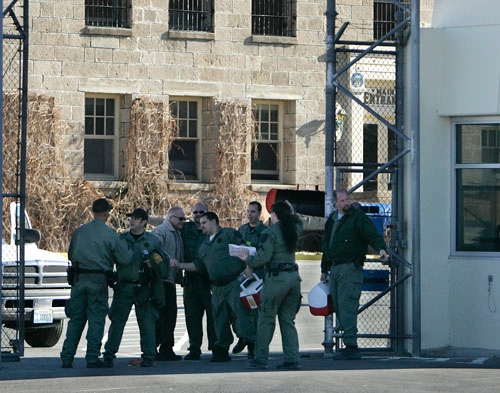Final day arrives at ‘The Max’ prison
CARSON CITY -- Correctional officers hugged each other, shouted "goodbye NSP" and shed tears as they trudged out of the Nevada State Prison for the last time Wednesday afternoon.
For 150 years, inmates have been housed in the sandstone prison, about two miles east of the Capitol, which opened two years before Nevada obtained statehood. That legacy will end today when the final seven inmates are moved to other prisons, a correctional officer said.
"It's over," the officer said. "We're done."
The corrections officer said the inmates will be gone and only four or five officers will report for duty today , but the Department of Corrections would not confirm that.
The officers' primary job will be preparing the facility for closure. At peak capacity, the prison held 821 inmates.
Steve Suwe, a prison spokesman, said a decommissioning ceremony for the prison will be conducted in late March.
He said that the prison will not be closed entirely because the state license plate factory on the prison grounds will remain open at least temporarily.
About 20 minimum-security inmates from a conservation camp work in the factory, which has made Nevada license plates since 1928. They are transported to and from the factory, so no inmates will remain in the prison at night.
Corrections Director Greg Cox might move that plant to another prison, probably the Northern Nevada Correctional Center in Carson City or High Desert State Prison near Indian Springs.
What will become of Nevada State Prison remains unknown. There has been talk of using at least part of it as a museum.
"We understand the enormity of it, the history of the prison," Suwe said.
This isn't just any state prison. Known as "The Max" because it housed all state prisoners for 100 years and the state's most violent inmates until 1989, the prison was the site of the nation's first execution in a gas chamber. Killer Gee Jon received the first lethal dose of gas in 1924.
It remains the only prison in Nevada with an execution chamber.
In all, 32 inmates were gassed in the prison before the law was changed requiring executions by lethal injection.
Starting with the execution of Las Vegas killer Jesse Bishop in 1979, 12 inmates have received lethal injections.
It also is the only prison in the nation where inmates ran their own casino. Once Nevada legalized gambling, prison officials decided inmates might as well have a casino, too. The Bull Pen casino operated from 1932 until 1967.
The closure will save the state an estimated $15 million a year. It costs less to feed and manage inmates in newer prisons. The annual cost per inmate at High Desert is $14,000, compared with $23,000 at Nevada State Prison.
Cox told the Board of Prison Commissioners in December that he had moved all but 140 inmates and 73 staff members to other prisons and that the old prison would be emptied by Jan. 9.
At the time, he said jobs had not been found for 13 correctional officers, who had refused offers to transfer to the Lovelock Correctional Center, more than 100 miles away.
Some might find jobs later through resignations or retirement of officers at other prisons.
Vishnu Subramaniam, chief of staff of the American Federation of State, County and Municipal Employees Local 4041, said 20 to 30 correctional officers will be out of work once the prison closes.
He expects most of them will find jobs by April 1.
"We fault the Department of Corrections for not having a better closing plan, but we are resigned to the fact they are closing it," he said. "They are taking appropriate steps to reduce the impact."
Contact Capital Bureau Chief Ed Vogel at evogel@reviewjournal.com or 775-687-3901.

















